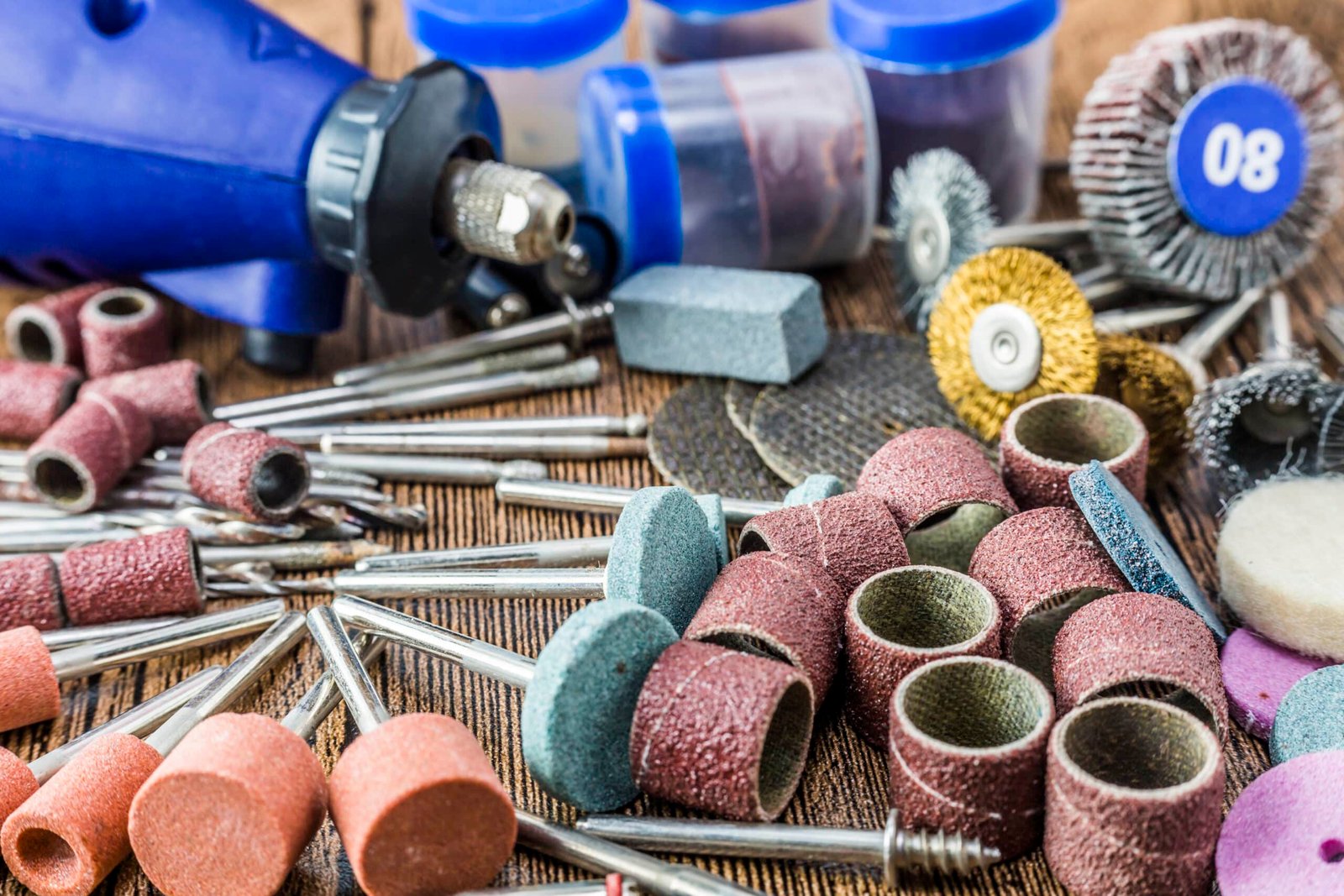When it comes to the world of woodworking, a tool that stands out for its efficiency and versatility is the drum sander. A drum sander is a powerful machine used to smooth wood and other materials, providing a finish that hand sanding or orbital sanders may not achieve as quickly or as evenly.

Drum Sand Paper
At its core, a drum sander consists of a spinning cylinder, or ‘drum’, wrapped with gritty sandpaper. The drum spins rapidly, and when a workpiece is fed into the machine, it is sanded by the abrasive surface of the drum. This tool is especially useful for larger projects or commercial settings, where speed, consistency, and quality of finish are paramount.
Drum sand paper is commonly used for tasks such as flattening and smoothing large wooden panels, preparing for the floor, or even creating beautiful finishes on a variety of woodworking projects. Its applications are not limited to wood, though. With the right type of sandpaper, a drum sander can be used on a range of materials including plastic and metal.
In this blog post, we will delve into the intricacies of the sandpaper used in drum sanders, discussing the different types, their specific uses, and how to choose the right one for your project. We will also guide you through the process of changing the sandpaper on your drum sander and provide tips on maintaining your tool. So, whether you’re a seasoned woodworker or a beginner, stick with us as we uncover the essentials of drum sanding.
Understanding Drum Sand Paper
Sandpaper is a vital component in the drum sanding process. It’s a type of coated abrasive that consists of sheets of paper or cloth with abrasive material glued to one face. Despite its name, sandpaper is not made from sand in modern times, but rather from a variety of man-made materials such as aluminum oxide or silicon carbide.
The role of sandpaper in drum sanding is to abrade or ‘sand’ the surface of the workpiece, which is usually wood but can also be metal or plastic. The sandpaper grinds away the surface layer, removing minor imperfections, smoothing the surface, or creating a specific shape or design.
The effectiveness of sandpaper is largely determined by its ‘grit’, a measure of the size of the abrasive materials on the sandpaper. The grit number refers to the number of abrasive particles per inch of sandpaper. The higher the grit number, the smaller the abrasive particles and hence the finer or smoother the finish will be. Conversely, lower grit numbers indicate larger abrasive particles and are used for more aggressive sanding to remove more material.
Selecting the right grit is crucial for achieving the desired finish. For instance, if you’re preparing a surface for painting, you might start with a lower grit to remove larger imperfections and then finish with a higher grit to achieve a smooth, paint-ready surface. On the other hand, if you’re trying to remove a lot of material quickly, a lower grit would be more appropriate.
In the context of drum sanders, the sandpaper is usually in the form of a long strip that is wound around the drum of the sander. The drum spins at a high speed, and the movement of the abrasive surface against the workpiece sands the surface.
In the next section, we’ll dive deeper into the different types of sandpaper that are suitable for drum sanders, and guide you on how to choose the right one for your specific needs.
Types of Abrasive Materials for Drum Sanders
Here’s what I concluded about the sandpaper you may want to consider for your wood-finishing project:

- Aluminum Oxide (A/O): This is one of the most popular abrasive materials and is the least expensive option on the market. It’s great for planning, stripping, roughing, and finishing on all wood types. Its longevity is less than other materials, but high-quality aluminum oxide is highly friable, meaning the tips of the abrasive grains fragment as it wears, continually providing sharp cutting surfaces, and increasing working life. This material is highly customizable to specific applications.
- Silicon Carbide (S/C): Silicon carbide is a specialty abrasive and works well for specific applications. It is harder and sharper than aluminum oxide, so the cut-rate remains the same throughout the entire life of the belt. Silicon carbide is more expensive than aluminum oxide, but its abrasives deliver a level of consistency that aluminum oxide abrasives cannot, which offsets the higher cost. It’s ideal for finishing stabilized wood, resins, epoxy, and other heat-sensitive applications. It is also excellent for automotive paint preparation and can be used on marble, garnet, glass, and other solid surfaces. It is typically black in color and suitable for applications requiring waterproof materials.
- Ceramic: This is considered a premium abrasive grain because it is extremely hard and sharp. Ceramic abrasives have the longest lifespan over any other type of abrasive material. They are ideal for the aggressive cutting of metals and hardwoods. The material works best when high speed and high pressure are applied. Ceramic is friable, continuously delivering a sharp cutting surface, increasing its longevity. However, they come with a premium price but could save you money over the long term. It is so aggressive that caution must be used to prevent scorching of the wood1.
- Zirconia or Alumina Zirconia (A/Z): This was the most aggressive and durable abrasive grain until ceramic came along. It is an excellent choice for heavy metal grinding/polishing of metals and material removal in hardwoods. Zirconia sanding belts are less costly than ceramic and do not typically exceed 220 grit. Zirconia is the middle-ground abrasive between aluminum oxide and ceramic in terms of price and longevity.
As for the types of sanding tools and their uses:
- Drum sanders: Drum sanders use an abrasive strip that is wrapped around a drum. The drum spins with a conveyor belt below it. The conveyor belt moves a workpiece so that it passes under the drum and is sanded. Drum sanders are commonly used for wood finishing.
- Orbital sanders: Orbital sanders use sanding discs and spin the discs in a circle. The rotating abrasive grains cut the surface the disc sander is applied. Orbital sanders don’t remove as much material as some of the other sanding tools and are better for finishing work.
- Handheld belt sanders: Handheld belt sanders are smaller belt sanders that use sanding belts. They can work well for leveling and smoothing rough wood boards.
- Benchtop belt sanders: Benchtop belt sanders are often larger and more powerful than handheld belt sanders. They are better at removing stock material from larger workpieces. They typically utilize longer sanding belts.
Different types of abrasives products are:
- Sanding belts: Great for jobs that require a lot of material to be removed quickly.
- Sanding discs: Good for sanding large surfaces if you don’t have a wide belt sander.
- Sanding sheets: Allow for a lighter touch for woodworking and finishing.
- Sanding rolls: Can be cut into sanding sheets or wound around drum sanders.
Choosing the Right Sandpaper for Your Drum Sander
Choosing the right sandpaper for your drum sander is an essential step in achieving the desired finish on your project. The sandpaper you choose should be determined by the finish you desire.

sandpaper
Choosing Based on Desired Finish
The finish you want to achieve also plays a big part in choosing the right sandpaper. Here’s a brief guide:
- Rough Finish: If you’re aiming for a rough finish or looking to remove a significant amount of material, consider a lower grit sandpaper. Zirconia or a coarse-grit aluminum oxide would be suitable for this task.
- Smooth Finish: If you’re seeking a smooth finish, a higher grit sandpaper would be the better choice. Silicon carbide is known for its ability to deliver a consistent, even cut, making it perfect for smooth finishes.
- Ultra-Smooth Finish: For an ultra-smooth or polished finish, consider a high-grit ceramic or silicon carbide sandpaper. The high cost of ceramic can be justified by its long lifespan and the quality of finish it provides.
Remember, the desired finish is not the only factor to consider when choosing sandpaper for your drum sander. The machine’s speed, the pressure applied, and your personal technique all play a part in the final result.
And always remember to sand safely. Wear appropriate safety gear, including eye protection and a dust mask, and always follow the manufacturer’s instructions for your sanding equipment.
How to Properly Install Sandpaper on Your Drum Sander
Please note that the process may vary slightly depending on the specific model of your drum sander. Always consult your machine’s user manual for model-specific instructions. Here is a general guide on how to change the sandpaper on a drum sander:
- Measure the Sandpaper: Begin by measuring the length and width of the sandpaper that you will need. The sandpaper should be enough to cover the whole surface of the sander’s base.
- Cut the Sandpaper: Use utility scissors to cut the sandpaper to the appropriate size. After cutting, place the sandpaper onto the sander’s base with the sandpaper’s smooth part. Ensure that the length of the sandpaper is parallel to the length of the sander and that there is no extra sandpaper.
- Attach One End of the Cut Sandpaper: Attach one end of the cut sandpaper to the clamping mechanism on top of one end of the sander. The clamping mechanisms for different sanders are not the same, so follow the manufacturer’s instructions in the owner’s manual to determine how to attach the sandpaper to the clamping mechanism.
- Wrap the Other End of the Sandpaper: Once you have attached one end of the sandpaper, you can wrap the other end of the sandpaper around the base of the sander.
- Secure the Sandpaper: Lift or open the clamping mechanism and attach the other end of the sandpaper to it. Pull the sandpaper with proper pressure when inserting it into the clamps to avoid slack, as slack can decrease the effectiveness of the sandpaper on a sanding surface. After you’ve secured the sandpaper, plug the sander into an outlet and turn it on to check whether everything is alright.
Knowing when to change your sandpaper is also crucial. You should replace your sandpaper immediately when it is clogged with the material you are sanding or if the abrasive side is worn down to smooth the surface. You can tell that the sandpaper is worn out when it is no longer flat or is clogged by dust, dirt, or debris, or when it fails to perform as effectively as it used to.
Maintaining Your Drum Sander: Cleaning and Care
Maintaining your drum sander is key to ensuring optimal performance and longevity of the tool. Proper care and regular cleaning can significantly enhance its effectiveness and durability. Here are some tips on how to clean and maintain your drum sander.

Wood shavings
- Clean After Each Use: After each use, make sure to clean your drum sander. Sawdust and other debris can build up on the drum and other parts of the sander, which can impact its performance. Use a brush or an air compressor to remove dust and debris from the machine.
- Regularly Check and Replace Sandpaper: The effectiveness of a drum sander greatly depends on the condition of the sandpaper. Monitor the sandpaper regularly and replace it when it becomes worn out or clogged. Worn-out sandpaper will fail to give the output it is used to and can make your sanding tasks more time-consuming and less efficient.
- Lubricate Moving Parts: Over time, the moving parts of your drum sander can become dry and less efficient. Regularly lubricate these parts to keep them running smoothly. Always use the lubricant recommended by the manufacturer.
- Inspect Belts and Chains: Belts and chains are crucial components of a drum sander. Regularly inspect them for any signs of wear and tear. If you notice any damage, replace these components immediately to avoid further damage or a potential breakdown.
- Keep the Conveyor Belt Tight: The conveyor belt of a drum sander should always be tight and aligned properly. A loose conveyor belt can cause the workpiece to slip, affecting the quality of your sanding. Check the conveyor belt regularly and adjust it according to the manufacturer’s instructions.
- Store in a Dry Place: Moisture can cause rust and damage to your drum sander. Always store your drum sander in a dry, clean place when not in use.
- Regular Servicing: Periodically, it may be beneficial to have your drum sander serviced by a professional. They can identify any potential issues early and ensure that the tool is in the best possible condition.
By following these maintenance and care tips, you can keep your drum sander in top condition and ensure its optimal performance. Remember, a well-maintained tool not only performs better but also lasts longer.
By understanding the above elements, you’ll be able to make the most of your drum sander, achieve professional-level finishes on your projects, and extend the life of your tool. Happy sanding!
Finally, drum sanders are an essential tool in a woodworker’s arsenal, playing a critical role in achieving smooth, even surfaces on wood. Understanding how to use, choose, and maintain a drum sander can significantly impact the quality of your woodworking projects and the lifespan of your tool.







